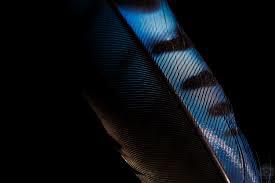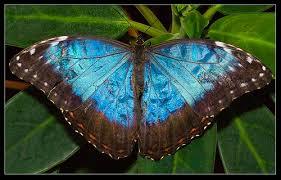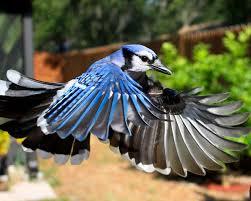
The thump was loud, like a packed snowball smacking the large window in the family room, only it was late April and the lilac tree, heady with clusters of purple blossoms, buzzed with bees. The blue jay was lying on the deck beneath the window, still and quiet, one iridescent blue, white, and black wing fanned at its side. I herded the dogs, Labrador retrievers, bird dogs, into the house since they might mistake this pliable, irresistibly warm body for a training toy.
A blue jay’s blues, its white, its opalescence doesn’t come from pigment, like a cardinal’s red or a goldfinch’s yellow, but from light. Structural light interference: light scattered across a keratin-air matrix that refracts wavelengths of color. Think of flashing, glimmering nano-landscapes: butterfly wings, beetle carapaces, and sardine scales. It’s why the colors of dead pigmented creatures fade but a peacock feather, plucked from the bird’s body, remains vibrant. Though, crush a jay feather and you destroy the reflective matrix, and blue turns black.

The jay’s eyes were closed, its long, narrow beak shut, but as its chest rose up and down, I imagined its four-chambered heart, the largest mammalian heart relative to body size, beating under the ruff of feathers. 164 beats per minute. Slower than a hummingbird’s 1200 bpm but faster than our 60-90 bpm. Perhaps the bird was just stunned by impact? I felt it was essential that the blow be glancing and not fatal. Despite it being spring, despite the welcomed thaw after six months of brutal winter, despite rooms filling again with sunlight, I was mired in depression’s quicksand, ruminating, most days, over methods of suicide. No optimistic rebirth-resurrection symbolism for me.
Years earlier, I found a dead sparrow in the grass and wondered if it fell straight from the sky. Birds, like humans, have heart attacks, and dying in flight seemed like the right way to go. The sparrow was recently dead—no decomposition, no flies, and when I scooped it up in a fistful of leaves, its body, dehydrated and built of hollow bones, was weightless. Really, just the weight of its palmed feathers, just the weight of flight’s shadow.
Blue jays are assertive, intelligent, fearless in protecting their young and their territory, and when they give chase, their loud screams serve as warning to the whole forest or neighborhood backyards. The Greeks called them Kyaneos (blue) Kitta (chattering). Watchbirds. For Native Americans, the blue jay’s blue-on-blue-eye-in-the-sky coloring signals clarity and vision. Inside depression’s architecture, the close, closing walls refuse light and reflect only the dark; so the blue jay’s clarity and vision, luminous translucence, was a flight path out of the mire. Wing beats. Heart beats.

The jay was heavy with life when I pushed at it with my gloved hand. I’d called the wildlife rehab center and the woman told me to wait an hour, to give the bird a chance to shake off the blow. How to shake off a blow? The question I was asking myself. That day, watching over the damaged bird, and for many surrounding years, I was desperate: starving myself, cutting my arms, unable to find equilibrium between bipolar’s mania and depression. My once loving marriage had become a prison: my then-husband, terrified that I would succeed in suicide, became my guard, following me after meals, hiding sharps, rotating surrogate-guards, interrogating me about what I was doing and feeling and thinking and planning. He helped keep my alive in his angry determination, but on constant watch, stopped loving me. Later, during our divorce, he said, matter-of-factly, “After you got sick, I couldn’t look at you the same. I didn’t love you anymore.” In simplistic retrospect, I couldn’t imagine divorce while my children were young, couldn’t imagine divorcing my then-husband who I didn’t really love anymore, either, but I’d promised my forever fidelity. Dying seemed the way out.
Blue jays form lifetime monogamous pair bonds: the birds build a nest together, and while the female broods the eggs, the male feeds her. If they choose to migrate, and not all do, and not every year, they travel together. Seven years on average, though some live to be seventeen. That was my understanding of marriage. Till death do us part. If we no longer felt love’s compassion and desire’s longing for each other? Then I would hasten my parting by death.
After an hour, I nudged the blue jay onto a dustpan and into a box lined with an old towel, and closed the lid. Was it still itself, a blue jay, in the dark? Without light’s generous revelation, its feathers would be black. And inside that box, would the dark offer safety or terror? I placed the box on the passenger seat and started the drive to the rehab center located miles down a rural dirt road. As I slowed for a four-way stop, I heard: thump thump thump. I pulled over onto the grass and lifted a corner of the lid. The jay was scrabbling to a stand. Both wings, now, were spread against the cardboard walls, prisms of blue and black. Its crest was ruffled in a blue, agitated bolt. I took the box out of the car, set it in the grass, and opened the top. With an upswell of feather and muscle, the blue jay took flight, slow wing beats at first and then with speed over the maple trees, and into the self-same sky.
My marriage was safe—a box, a nest—but I brooded for years, afraid to risk flight. After my divorce, a friend and I were walking through the woods, talking about the terror of liberation, about the heartache of necessary change. We paused to watch a blue jay pair give chase to a crow, threading themselves through the leaf canopy, lustrous ribbons of sky.

“I don’t know if I should tell you,” she said, “but years ago, I had a dream. You were walking down stairs and I was walking up when you slid your wedding band from your finger, and gave it to me. You said, ‘If I wear this any longer, I’ll die.’ I was afraid to tell you about the dream then because things were precarious for you, but I always wondered what might have changed sooner if I hadn’t waited.”
Rilke writes, “How surely gravity's law, strong as an ocean current, takes hold of the smallest thing and pulls it toward the heart of the world….This is what the things can teach us: to fall, patiently, to trust our heaviness. Even a bird has to do that before he can fly.”
I won’t belabor the obvious analogies between my blue jay risking flight even in its precarious condition, and how its own body’s architecture was the reason for light’s profligate wave of color, and how its enormous, four-chambered heart was the reason it could risk its heaviness in flight. Suffice it to say, I have a blue jay tattoo in my skin, pigmented colors, of course, but still, I scatter light and shimmer as I fly into the heart of the world.
